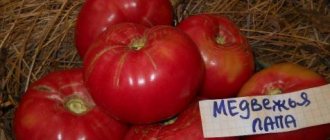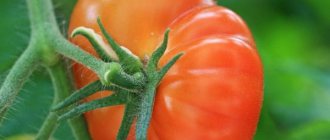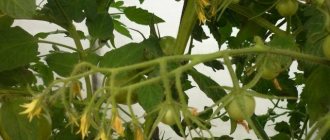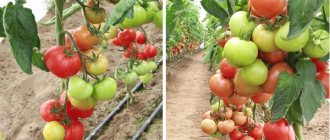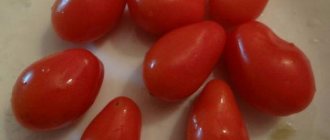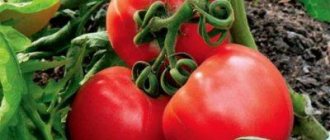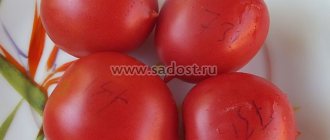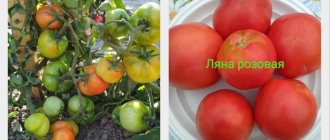History of the variety's creation
Tomato Bear's Blood
The Bear's Blood variety was developed by several breeders. The crossing took place in Nizhny Novgorod and before it was successful, a lot of work was done, as a result of which a new variety appeared. The new variety has passed all tests. It has proven to be productive, well adapted to a temperate climate and little change in the environment. Bear blood began to be sold only recently, but the variety is slowly gaining popularity.
What are the advantages of this variety?
The advantages of Bear's Blood tomatoes include:
- high productivity and independence from climatic conditions;
- fruit aroma and real tomato taste;
- Possibility of storing tomatoes;
- the variety bears fruit even when the temperature drops to +14 degrees;
- the bush does not take up much space, as it is low and bulky;
- caring for plants is simple;
- resistance to infections and pests at the genetic level;
- this variety gives a good harvest everywhere: in the open ground and in the greenhouse.
This variety has no negative qualities, but gardeners highlight some points that make care difficult - the need to install supports for the bushes due to the large fruits and the shelf life is no more than two weeks.
Tomatoes Bear's Blood: a detailed description of the tomato variety
Tomatoes Bear's Blood: photo
This variety was created specifically for cultivation in temperate climates, in open ground. If the climate is colder, then it is recommended to plant in closed ground, that is, in film or glass greenhouses. The plant tolerates various frosts well and also produces a fairly large, regular harvest. The variety is resistant to short-term drought. All processes in a tomato occur regardless of the presence of sunlight; this variety is very different from its peers, since many tomatoes cannot produce photosynthesis without the sun. It belongs to the early ripening varieties. For the fruits to fully ripen, it usually takes about 90 days after transplanting into open or closed ground.
Description of the plant
The average height of the variety usually ranges from 80 to 100 centimeters; it belongs to varieties of medium growth, and it is also worth noting that growth stops after the bush has flowered. The bush is not spreading, but has several lateral stems; these stems are not used when forming. The variety must be formed by only one, the main shoot, which is located in the center, the rest will have to be removed. To ensure large fruits, some of the ovaries are removed.
Description of the Bear's Blood tomato bush
- Loose arrangement of leaves, leaves are quite small. The leaf itself is dark green in color with teeth along the edge, the surface of the leaf looks like corrugated paper, and it is also covered with a small fluff. The top of the leaf has a darker shade than the bottom.
- The main stem, which is located in the middle, is very thick and strong, it has a brownish color with a green tint. The shoots growing on the sides are light green in color and very poorly developed.
- The crop is bisexual, so it pollinates itself and does not require additional pollinating plants. The flowers are deep yellow during the flowering period.
- The root system belongs to the fibrous system. It grows quite well and forms a circle with a diameter of about 70 centimeters.
- The bunch of tomatoes is quite dense, about 6-8 ovaries. The brushes are located after 1-2 sheets. When forming, you should leave only 4-5 clusters on the bush, which are strong and will bear fruit; each cluster should have about 5-6 tomatoes. Since the variety is large-fruited, the ovaries will not develop in large quantities, and you may be left completely without a harvest.
Fruit ripening occurs unevenly. The first collection is already carried out in mid-August, and the last collection 10-20 days before the first frost. It is worth noting that when grown in a greenhouse, the first harvest will take place in early August.
Note: This variety is one of the few varieties that produce whole seeds. These seeds retain all the information about the variety.
Description of the fruits of the Bear's Blood tomato variety
- The fruits are round in shape with fairly high shoulders, the surface is divided into unequal parts. Each tomato weighs on average about 400 grams; if the density of the bunch is normal, then they reach up to 700 grams.
- They have a uniform color, the skin is uniform, without bumps and shiny.
- The skin is dense and protects the fruit well from injury, so during long-term transportation they do not crack, but remain the same.
- The pulp has a pleasant aroma and taste, the tomato is very fleshy and loose, and also has many chambers. Usually the fruits do not have white parts.
- The sweet taste of tomatoes without sourness manifests itself with proper care.
- The seeds are ivory colored and quite large in size.
After the fruits have been collected, the tomato remains the same for 10-15 days. This variety is perfect for sale, as well as for ordinary home preparations, since tomatoes are universal and can be used anywhere. You can make juices, pastes, ketchup from them, or you can simply eat them fresh.
Fruit characteristics
Bear's blood is a typical beef tomato. The fruits are large, green with a dark spot at the technical stage, after full ripening they are deep red. The shape is flat-round, with a strongly depressed stalk. Nests – more than 6.
The weight of tomatoes depends on the formation of the bush and the normalization of the ovaries, the average is 200-300 g. The surface of such fruits is almost smooth, slightly ribbed.
Similar varieties
Tomatoes are similar in characteristics to Bear's Blood:
- Alsou. Tomato from agro, in the State Register since 2008. Early for open ground, determinate, with a bush height of about 80 cm. Tomatoes are flat-round in shape, red, fleshy, slightly ribbed, average weight without standardization - 300 g, chambers - 6 or more. Marketable yield per sq. m – 7 kg, total – higher.
- Big jackpot. The tomato is not included in the State Register; the selection is from the Siberian Garden. Determinate, early, long-term fruiting, up to 90-100 cm high. Recommended for open ground. The tomatoes are flattened, dark red, with faint ribs. The pulp is sweet, fleshy. From 1 sq. m harvest up to 12 kg.
- Vologda fruitful. Mid-early for open ground. Determinate, up to 1 m high. 250-400 g, fleshy tomatoes, multi-chambered, bright red, compressed at the poles. The tomato yields a harvest of up to 4 kg per bush.
Bear's blood is a new variety, all the features of which gardeners have yet to study. But the tomato has already shown itself to be productive and tasty. The fact that it requires compliance with the rules of agricultural technology cannot be considered a minus.
Tomato Bear's Blood: main characteristics
Bear's blood is a tomato variety that tolerates frost and drought well. During the growing season, it functions well even at night when the outside temperature drops.
When grown in a greenhouse, the plant develops even better, since there is no need to waste energy on warming.
When the soil dries out a little, the variety feels comfortable, but if you start adding excess moisture to the soil, the root system may begin to rot and the plant will die.
Tomatoes of the Bear's Blood variety are characterized by regular and high yields, while the process of fruit formation is not affected by weather or climate factors. The yield level when grown in open and closed ground is almost the same, the only difference is that in a greenhouse tomatoes ripen 2-3 weeks earlier.
When planting in open ground, you don’t have to worry about part of the plot; the variety can also be planted in the northern part of the territory.
The best option for this variety would be to have a small building nearby, since there will be no draft, which the variety does not tolerate very well.
The bush will develop equally in a sunny or dark place; the sun's rays do not spoil the fruits due to the dense shell.
Since the variety is a medium-sized variety, it produces good yields. The average yield from each bush is about 4 kilograms. For a good harvest, the distance between the bushes must be maintained at about 20-25 centimeters. The bush requires minimal care and does not require anything additional.
The first wave of tomatoes grown indoors will ripen by the end of July and harvesting can begin in early August, the last wave will end around the beginning of October or the end of September. If the fruits are not fully ripened, there is no need to worry, you just need to put them in a dark place and they will ripen on their own. Tomatoes growing in open ground are harvested at the end of summer.
The fruits of this variety have a strong immune system; when changes were made to the variety, it was given resistance to major diseases, such as fusarium, late blight, and cladospora.
When grown in a greenhouse and the temperature and humidity are not maintained, a tomato can be affected by fungal diseases, for example, microsporia. Such diseases most often appear on leaves and shoots.
In order to get rid of the fungus, you need to remove infected leaves and shoots, ventilate the greenhouse, add nitrogen fertilizer to the soil and treat the surface of the bush with a product with a high copper content.
Pests in a greenhouse are not terrible, but in open ground Colorado beetles can settle on a bush. In this case, the bush is treated with Chlorophos.
Resistance to diseases and pests
The State Register says nothing about the susceptibility of the variety to diseases. The breeder, agro, declares good immunity and high resistance. Gardeners, even those who scold the tomato for real or imaginary shortcomings, note that it actually gets sick less than other tomatoes.
Preventative treatments still need to be done. It is recommended to spray the bushes and water the soil with a solution of Fitosporin or Trichoderma.
Fruiting
The variety is early, but if agricultural practices are incorrect, namely, overfeeding with nitrogen, the ripening of tomatoes may be delayed.
Bear's Blood tomatoes, like most beefs, are not highly marketable. Some of the largest fruits are deformed or cracked. However, this does not affect the taste at all.
Productivity
The Bear's Blood variety is a real beef tomato, distinguished by very fleshy fruit pulp and a small number of seed chambers. The fruits are large, reaching a weight of 300 - 500 g. In greenhouse conditions, the tomato yield is 12 kg m2. m, if the necessary care is provided for them. Productivity in open ground is somewhat less.
Optimal growing conditions
Bear's Blood tomatoes love warmth and light, although they can tolerate light shading and lower temperatures. Seeds germinate already at 15 ° C, but the optimal temperature is 25 ° C. At 10 °C they stop growing, at 35 °C they are not able to pollinate. A severe lack of light can cause plants to stretch out.
My favorite tomato varieties
So 2021 has begun. It’s cold and gray outside, but spring is getting closer and closer every day, which means the time for sowing seeds for seedlings is approaching. Probably every summer resident has his own “favorites”. So I want to talk about the tomatoes that I plant every year.
I’ll immediately make a reservation that due to the climate, all my tomatoes grow in a greenhouse. I grow only indeterminate varieties, forming plants into 1 stem. Every year I select and plant 2-3 new varieties of tomatoes, but the main part of the greenhouse is occupied by my “favorites”: 'De Barao black', 'Pepper striped', 'Konigsberg', 'Yellow ball', 'Magic cascade', 'Red date' '.
My tomato “favorites”. The only thing missing is the seeds of the 'Konigsberg' variety
'De Barao black'
Medium-late ripening variety (115–120 days). The fruits are small, weighing up to 60 g, very good for preservation. The advantages of the variety include its fertility, a fairly long fruiting period (I harvest the last tomatoes in October) and relative resistance to late blight.
Tomato 'De Barao black'
'Pepper-striped'
Refers to mid-early varieties (10–110 days). The fruits are elongated, with an original color (this year they grew pepper-shaped, but for some reason without stripes!), weighing up to 120 g, fleshy and juicy, so they go well in salads or preparations such as lecho or borscht dressing.
Tomato 'Pepper striped'
'Konigsberg'
Mid-season variety (110–115 days). Under favorable conditions, clusters of 4–5 fairly large fruits weighing up to 300 g are formed on the plant. The fruits are elongated, fleshy and juicy, and have a universal purpose. I prefer to eat them fresh. Resistant to late blight.
Tomato 'Konigsberg'
'Yellow Ball'
Mid-early variety (105–110 days). Last season it was one of the first to bear fruit. The fruits are small, round, yellow, juicy and sweet, weighing up to 150 g. Table variety.
Tomato 'Yellow Ball'
'Magic Cascade'
This variety belongs to cherry tomatoes. Early ripening (89–90 days). The plant produces long clusters with small rounded fruits weighing up to 20 g. Perfect for whole-fruit canning and drying.
Tomato 'Magic Cascade'
'Date red'
Another cherry tomato. This one is probably my favorite. Medium late (110–115 days). Very prolific. The shape of the fruits really resembles dates, they are very sweet, and are suitable for whole-fruit canning and drying. A huge number of these tomatoes in our family are eaten “without anything”, because they are very tasty)) This variety of tomatoes in my greenhouse is the last to finish bearing fruit!
Tomato 'Date red'
Previously I grew 'Orange date'. In terms of taste, it’s no worse than red, and it’s also a beautiful color. But, unfortunately, agro has stopped releasing this variety for sale separately. I tried to buy a mixture of Dates varieties (red, yellow, orange and pink), but only red and yellow ones grew. So now I only buy 'Red Date'.
I would be grateful if in the comments someone would share the names of their “favorites” or a link to a similar description of their favorite varieties of tomatoes.
Rules for planting and care
The Bear's Blood tomato variety, regardless of the growing method, is propagated only from seedlings. Seeds are planted at the end of March; seedlings are planted in a permanent bed at the age of 45 days.
Sowing seeds for seedlings
Before growing planting material, prepare containers; wooden or plastic containers are suitable. The seeds are sown in fertile soil; you can purchase it or mix it yourself. The soil consists of peat, sand, and turf layer. Add 100 g of nitrogen per 10 kg of mixture.
Sequence of work:
- Soil is poured into the boxes and watered.
- Place the seeds in furrows 1.5 cm deep, at intervals of 1 cm.
- They fall asleep and water.
- Cover the top with glass, film or polycarbonate.
- Place in a room with a temperature of +22 °C.
After the growth appears, the covering material is removed. Water no more than 2 times a week. When the fourth leaf appears, feed with complex fertilizers. A day after fertilizing, the seedlings are planted in plastic or peat cups. In this state, it is in the light and warm for 8 days, then the planting material is determined for a permanent place.
Growing seedlings
To grow high-quality Bear's Blood tomato seedlings, preparation of soil, seeds and containers is necessary.
A soil mixture consisting of peat, sand, compost, garden soil is sifted and disinfected by calcination, freezing, and treatment with special means. Seeds are sorted, disinfected, hardened, and bubbling.
Containers for the further cultivation of bear blood tomato seedlings are treated with disinfectants.
50 - 60 days before planting seedlings in open or closed ground, sow seeds:
- The containers are filled with moist soil mixture.
- Tomato seeds are placed in prepared grooves 1 cm deep at intervals of 3 cm from each other.
- Sprinkle them with soil.
- The containers are covered with film.
- Place the boxes in a warm place.
- After the shoots emerge, the film is removed.
For complete lighting, artificial lamps are installed above containers with seedlings and additionally illuminated for 16 hours a day.
A week and a half after the emergence of shoots and “real” leaves, the seedlings are plucked. Repeated picking of Bear's Blood tomatoes is carried out after 2 weeks. At the age of 40 - 45 days, flower clusters appear on the seedlings. Planting plants in open ground should not be delayed so that the plants do not stretch out and lose future ovaries.
Important! Bear's Blood tomato seedlings are considered high quality if they have thick stems, dark green leaves, and a developed root system.
Planting seedlings
This variety is grown by seedlings, that is, before transplanting it into open or closed ground, the Bear's Blood tomato seeds must be sown at home and wait until the sprouts of the required height appear. Sowing of seedlings is carried out in early April, and transplantation is carried out 50 days after planting the seedlings.
Before planting seedlings, you need to prepare everything you need. For this we need containers, they can be any kind, either wooden or plastic, it doesn’t matter. You also need Bear's Blood tomato seeds and prepared soil where the seeds will be planted. To prepare the soil, it must be fed with a mixture that includes peat, sand, turf layer, and 50 grams of nitrogen.
Transplantation into the ground
The bushes are transplanted at the end of spring, or more precisely in the second half of May. If the sprouts are in peat cups, then they can be placed in the ground directly in the cups. If the sprouts are in plastic cups, then they should be cut and planted together with the soil from the container. If the site is not protected, then it is planted there only after the earth has warmed to +18 degrees. Note: To ensure good rooting in a new location, the plant should be covered at night for days after transplantation.
Landing
Growing seedlings
To plant seedlings, you first need to prepare a suitable substrate. It should be a mixture of earth, humus and sand. If you have no experience in preparing such preparations, the substrate can be purchased at a gardening store.
To ensure that the seedlings are guaranteed to germinate, it is recommended to test the germination of the seeds. If they are good, then you can start planting:
- we prepare containers for seedlings, boxes, plastic cups, etc.;
- pour moistened soil there;
- plant the seeds to a depth of 2 cm;
- cover the containers with film;
- We put them in a warm place, maybe on a windowsill, and leave them for a week.
Next, when slightly sprouted sprouts are visible from the ground, remove the film. We give more light and monitor the air temperature, it should be within 20 - 25 degrees. We also don’t forget about watering; we do it as soon as we see a dried crust of soil.
After three weeks we carry out a pick
This must be done carefully so as not to damage the roots. In the process, you can feed the plant with nitrogen microelements
Landing in the ground
Planting in open ground occurs after two months. At this time, the temperature outside is already optimal. The best option is to transplant the seedlings into a greenhouse. The land is prepared for this in the fall.
Planting stages:
- first of all, we fertilize the soil by adding humus or compost;
- we make holes in a checkerboard pattern, maintaining a distance of at least 60 cm;
- we plant the seedlings in moistened soil and lightly compact them;
- pour warm water.
Tomato care
Agricultural technology for tomato variety Bear's Blood includes:
- formation of a bush by one shoot, removal of stepsons;
- loosening as the crust forms, necessary for oxygen to reach the roots, removing weeds from the bed;
- tying the bush is carried out when the tomato has faded, the top is not broken off;
- moderate watering, do not allow the soil to become waterlogged:
- mulching with straw immediately after planting.
Bear blood tomato is fertilized once every 25 days; organic matter, complex fertilizers and microelements are used.
Watering and fertilizing
Watering tomatoes after planting in the ground is carried out once a week, spending up to 5 liters per bush, strictly at the root. Sprinkling is harmful to plants because it causes buds to fall off, delayed fruit set, and the appearance of fungal diseases.
During flowering, the watering rate is reduced to 2 liters per bush. When the fruits form and grow, moistening is carried out twice a week at the rate of 3 liters per plant.
If you do not follow the watering schedule, the fruits of Bear's Blood tomatoes may crack, crumble, and there is a high probability of developing blossom end rot.
Fertilizing is carried out three times per season: with nitrogen, phosphorus-potassium and microfertilizers. Do not neglect the addition of organic matter (mullein infusion, weeds, bird droppings, ash).
Pinching and tying
The height of Bear's Blood tomato bushes is about 100 cm. Stepchildren must be removed, otherwise their growth will lead to thickening of the bush, fruit growth will stop, and it will be replaced by the formation of a large amount of green leafy mass.
After the bushes bloom and reach a height of 0.5 m, the tomatoes should be tied up. Judging by the reviews, photos, videos about the Bear's Blood tomato, its yield is high, the fruits are large, so reliable support is necessary. Gartering should be carried out regularly, at least once every two weeks, combining it with regular stepsoning.
Formation
The originator of the Bear's Blood variety recommends forming a bush with one or two stems. To do this, it is necessary to remove excess stepsons. In order to increase the growth of the main stem, the crown inflorescences must be pinched.
Landing
The first step towards obtaining a harvest of the Intuition variety is growing seedlings, which, in turn, should emerge from seeds. The latter should be planted in wooden or plastic containers. Seedling boxes should be thoroughly disinfected before filling with soil.
You can create the soil itself, which is optimal for growing Intuition, yourself. To do this, you need to mix humus with peat and regular soil. It wouldn't hurt to add wood ash and a little superphosphate. However, you can also purchase ready-made soil. In the latter case, you do not need to add anything to it - it already contains all the substances necessary for the successful growth of seedlings.
Landing in the ground
It is recommended to transplant the seedlings into the soil of the greenhouse when the seedlings reach a height of ten centimeters. But what is not recommended is planting seedlings on the soil on which peppers, cabbage (of any kind) or eggplants previously grew. By the way, despite the fact that planting takes place indoors, experienced gardeners advise doing it in cloudy weather and in the evening, and moistening the soil itself with a light solution of potassium permanganate.
The seedlings themselves should be planted at a shallow depth in order to prevent the growth of new roots, which, in turn, can negatively affect the growth of the bush itself.
Protection from diseases and pests
The Bear's Blood tomato is easy to care for and resistant to most diseases and pests. Under unfavorable weather conditions and poor agricultural practices, the plant may be affected by diseases:
- late blight;
- brown spotting;
- gray rot.
In order to prevent diseases, experts recommend treating tomatoes with drugs to strengthen the immune system, and to combat pathologies - the use of chemicals based on copper sulfate.
Among the main pests of tomatoes:
- whitefly;
- mole cricket;
- Colorado beetle.
They can be destroyed by using traps with bait, drugs “Thunder”, “Phosbecid”.
Landing
Growing seedlings
Sowing of seeds is carried out from March 20 to April 10. A mixture of peat, sand and humus is disinfected. You can calcine the soil in the oven or treat it with a disinfectant. Or purchase a ready-made substrate for growing tomatoes in the store.
Containers for growing seedlings and the seeds themselves are also disinfected. To do this, they are soaked in warm water or a growth stimulant. The sunken seeds are ready for planting. They are laid to a depth of 1-2 centimeters, sprinkled with a thin layer of humus on top.
The seedlings are watered, covered with film and placed in a warm, bright place. If the top layer of soil begins to dry out, moisten it with a spray bottle. When the first shoots appear, the film is removed, the seedlings are provided with good lighting: their daylight hours should last at least 16 hours. If necessary, use special lamps for illumination.
Tomatoes peak when four leaves appear. The day before, the seedlings are fed with complex fertilizers. After 50-60 days, the first brushes appear on the plants. You cannot delay planting in the ground: otherwise the tomatoes will stretch out and lose their ovaries.
Landing in the ground
A week before planting seedlings in the ground, the soil is treated with a solution of copper sulfate. Holes are prepared for tomatoes: the distance between rows should be 60 centimeters, between plants - 50 centimeters. The variety easily tolerates a lack of sunlight, so tomatoes can be planted in shaded areas.
“Bear Blood” is transferred to the greenhouse in mid-May. The seedlings are well watered beforehand. Peat cups are placed in the ground along with the container, plastic cups are cut and planted in the ground with a lump of earth. Tomatoes can be placed in an open bed when the ground warms up to 15-18 degrees. In the first days after moving to a permanent place of residence, tomatoes are covered at night and protected from sunlight.
Characteristics of the variety
| Variety type | Hybrid |
| Bush type | Indeterminate |
| Soil type | Open ground |
| Precocity | Mid-season |
| Color | Red |
| Fruit weight | 79 g |
| Productivity | 10.5 kg/sq.m |
| Taste qualities | Fine |
| Application | Salads |
| Number of nests | 3 |
Intuition is one of the most popular tomato varieties. He has earned his recognition among gardeners for his high productivity on the one hand, and unpretentiousness and ease of care on the other.
Landing
The first step towards obtaining a harvest of the Intuition variety is growing seedlings, which, in turn, should emerge from seeds. The latter should be planted in wooden or plastic containers. Seedling boxes should be thoroughly disinfected before filling with soil.
You can create the soil itself, which is optimal for growing Intuition, yourself. To do this, you need to mix humus with peat and regular soil. It wouldn't hurt to add wood ash and a little superphosphate. However, you can also purchase ready-made soil. In the latter case, you do not need to add anything to it - it already contains all the substances necessary for the successful growth of seedlings.
Landing in the ground
It is recommended to transplant the seedlings into the soil of the greenhouse when the seedlings reach a height of ten centimeters. But what is not recommended is planting seedlings on the soil on which peppers, cabbage (of any kind) or eggplants previously grew. By the way, despite the fact that planting takes place indoors, experienced gardeners advise doing it in cloudy weather and in the evening, and moistening the soil itself with a light solution of potassium permanganate.
The seedlings themselves should be planted at a shallow depth in order to prevent the growth of new roots, which, in turn, can negatively affect the growth of the bush itself.
Pest and disease control
Disease prevention is carried out by treating the soil with a hot solution of potassium permanganate before planting Bear's Paw seedlings. To prevent root rot and other types of rot, after watering in greenhouses, open the windows, and mulch the plant holes in the soil with peat or straw.
An aqueous solution of ammonia saves the tomato variety from the Colorado potato beetle and slugs. Aphids are expelled by spraying with soapy water. Insecticide sprays protect tomatoes from flying insects.
Attention! After the formation of the ovary, spraying is carried out only with decoctions of chamomile, celandine, and onion peels. When one bush is infected, the entire plot is treated.
